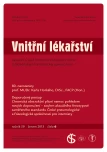Resistant hypertension in the elderly
Authors:
Ľ. Gašpar; I. Balažovjech
Authors‘ workplace:
II. interná klinika Lekárskej fakulty UK a UN Bratislava, Slovenská republika, prednosta doc. MU Dr. Ľudovít Gašpar, CSc.
Published in:
Vnitř Lék 2013; 59(6): 459-462
Category:
80th birthday prof. MUDr. Karla Horkého, DrSc., FACP (Hon.)
Overview
The issue of resistant hypertension is complex and from the clinical aspect very current, especially in the elderly. For the diagnosis of resistant hypertension in routine practice, ambulatory blood pressure monitoring is a proven method to distinguish it from the white coat hypertension. Fixed combinations of antihypertensive drugs helps to improve compliance not only in geriatric patients, but are also indicated in hypertensive patients with diabetes mellitus, metabolic syndrome, in patients with target organ damage, renal disease, coronary heart disease and post stroke conditions. Especially in the population of older hypertensive patients, listed diseases with polymorbidity are frequently present.
Key words:
resistant hypertension – definition of resistant hypertension – occurrence of resistant hypertension – causes of resistant hypertension – ambulatory blood pressure monitoring – atherosclerosis
Sources
1. Calhoun DA, Jones D, Textor S et al. Resistant hypertension: diagnosis, evaluation, and treatment: a scientific statement from the American Heart Association Professional Education Committee of the Council for High Blood Pressure Research. Hypertension 2008; 51 : 1403 – 1419.
2. Gašpar Ľ, Makovník M, Hlinšťáková S et al. Médiokalcinóza – marker zvýšeného kardiovaskulárneho rizika. Vask Med 2011; 3 : 29 – 31.
3. Widimský J. Léčba hypertenze v každodenní praxi. Med pro Praxi 2010; 7 : 257 – 262.
4. Aktualizácia Národného programu podpory zdravia v Slovenskej republike, rok 2011. Bratislava: ÚVZ SR 2011 : 1 – 22.
5. Mancia G, De Backer G, Dominiczak A et al. 2007 Guidelines for the management of arterial hypertension: the task force for the management of arterial hypertension of the European Society of Hypertension (ESH) and of the European Society of Cardiology (ESC). J Hypertens 2007; 25 : 1105 – 1187.
6. Mancia G, Laurent S, Agabiti - Rosei E et al. Reappraisal of European guidelines on hypertension management: a European Society of Hypertension Task force document. J Hypertens 2009; 27 : 2121 – 2158.
7. Gavorník P, Dukát A, Gašpar Ľ et al. Endotelová dysfunkcia a multiorgánovomultivaskulárna (polyorgánovopolyvaskulárna) choroba. Forum Diab 2012; 1 : 77 – 85.
8. de la Sierra A, Segura J, Banegas JR et al. Clinical features of 8 295 patients with resistant hypertension classified on the basis of ambulatory blood pressure monitoring. Hypertension 2011; 57 : 898 – 902.
9. Grassi G, Cifkova R, Laurent S et al. Blood pressure control and cardiovascular risk profile in hypertensive patients from central and eastern European countries: results of the BP - CARE study. Eur Heart J 2011; 32 : 218 – 225.
10. Štrauch B, Chytil L, Kurcová I et al. Jak posoudit non‑compliance k farmakoterapii u těžké rezistentní hypertenze? Cor Vasa 2011; 53 : 429 – 432.
11. Gelber RP, Gaziano JM, Orav EJ et al. Measures of obesity and cardiovascular risk among men and women. J Am Coll Cardiol 2008; 52 : 605 – 615.
12. Gašpar Ľ, Poliak P, Makovník M et al. Obezita a artériová hypertenzia. Vnitř Lék 2010; 56 : 1074 – 1077.
13. Mottillo S, Filion KB, Genest J et al. The metabolic syndrome and cardiovascular risk. A systematic review and meta‑analysis. J Am Coll Cardiol 2010; 56 : 1113 – 1132.
14. Ezzati M, Henley J, Thun MJ et al. Role of smoking in global and regional cardiovascular mortality. Circulation 2005; 112 : 489 – 497.
15. Ochaba R, Rovný I, Bielik I. Ochrana detí a mládeže – tabak, alkohol a drogy. Bratislava: ÚVZ SR 2009 : 1 – 185.
16. Criqui MH, Ninomiya JK, Wingard DL et al. Progression of peripheral arterial disease predicts cardiovascular disease morbidity and mortality. JACC 2008; 52 : 1736 – 1742.
17. Go AS, Chertow GM, Fan D et al. Chronic kidney disease and the risks of death, cardiovascular events, and hospitalization. N Engl J Med 2004; 351 : 1296 – 1305.
18. Egan BM, Zhao Y, Axon RN. US trends in prevalence, awareness, treatment, and control of hypertension, 1988 – 2008. JAMA 2010; 303 : 2043 – 2050.
19. Staessen JA, Thijs L, Fagard R et al. Predicting cardiovascular risk using conventional vs ambulatory blood pressure in older patients with systolic hypertension. Systolic Hypertension in Europe Trial Investigators. JAMA 1999; 282 : 539 – 546.
20. Hermida RC, Ayala DE, Fernández JR et al. Chronotherapy improves blood pressure control and reverts nondipper pattern in patients with resistant hypertension. Hypertension 2008; 51 : 69 – 76.
Labels
Diabetology Endocrinology Internal medicineArticle was published in
Internal Medicine

2013 Issue 6
Most read in this issue
- Differential diagnosis and treatment of hyponatremia
- Impact of pregnancy on pituitary disorders
- Diuretics in monotherapy and in combination with other diuretics and non‑diuretics in the treatment of hypertension
- The environmental estrogen bisphenol A and its effects on the human organism
